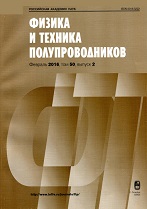|
This article is cited in 3 scientific papers (total in 3 papers)
Electronic properties of semiconductors
Influence of annealing on the properties of Ge:Sb/Si(001) layers with an antimony concentration above its equilibrium solubility in germanium
D. V. Yurasov, N. A. Baidakova, M. N. Drozdov, E. E. Morozova, M. A. Kalinnikov, A. V. Novikov
Institute for Physics of Microstructures, Russian Academy of Sciences, Nizhnii Novgorod
Abstract:
The influence of rapid thermal annealing on the electrical and radiative properties of Ge:Sb/Si(001) epitaxial layers with an antimony concentration substantially higher than its equilibrium solubility in germanium is investigated. Local variations in the electrical and luminescence properties of $n$-Ge/Si(001) throughout the structure depth are investigated by means of the precise chemical etching of Ge. It is shown that a variation in the properties of such layers at relatively low ($\le$ 500$^\circ$C) annealing temperatures (decrease in the electron concentration and photoluminescence intensity) occur in the absence of the noticeable diffusion-related redistribution of dopant atoms. Variations in the electrical and luminescence properties of Ge:Sb layers at relatively high ($\ge$ 700$^\circ$C) annealing temperatures are caused by the substantial redistribution of Sb due to its bulk diffusion and desorption from the surface. In particular, Sb diffusion leads to the formation of doped layers in initially undoped parts of the studied structures, which start to give a substantial contribution to the resulting conductivity of the structure and its photoluminescence signal.
Received: 25.02.2019
Revised: 05.03.2019
Accepted: 05.03.2019
Citation:
D. V. Yurasov, N. A. Baidakova, M. N. Drozdov, E. E. Morozova, M. A. Kalinnikov, A. V. Novikov, “Influence of annealing on the properties of Ge:Sb/Si(001) layers with an antimony concentration above its equilibrium solubility in germanium”, Fizika i Tekhnika Poluprovodnikov, 53:7 (2019), 897–902; Semiconductors, 53:7 (2019), 882–886
Linking options:
https://www.mathnet.ru/eng/phts5452 https://www.mathnet.ru/eng/phts/v53/i7/p897
|


| Statistics & downloads: |
| Abstract page: | 46 | | Full-text PDF : | 19 |
|





 Contact us:
Contact us: Terms of Use
Terms of Use
 Registration to the website
Registration to the website Logotypes
Logotypes








 Citation in format
Citation in format 
